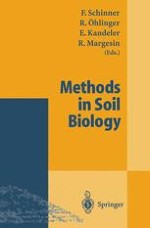1996 | OriginalPaper | Buchkapitel
Soil Respiration
verfasst von : R. Ölinger, T. Beck, B. Heilmann, F. Beese
Erschienen in: Methods in Soil Biology
Verlag: Springer Berlin Heidelberg
Enthalten in: Professional Book Archive
Aktivieren Sie unsere intelligente Suche, um passende Fachinhalte oder Patente zu finden.
Wählen Sie Textabschnitte aus um mit Künstlicher Intelligenz passenden Patente zu finden. powered by
Markieren Sie Textabschnitte, um KI-gestützt weitere passende Inhalte zu finden. powered by
Microbial respiration (soil respiration) is defined as oxygen uptake or carbon dioxide evolution by bacteria, fungi, algae and protozoans, and includes the gas exchange of aerobic and anaerobic metabolism (Anderson 1982). Soil respiration results from the degradation of organic matter (e.g. mineralization of harvest residues). This soil biological activity consists of numerous individual activities; the formation of C02 is the last step of carbon mineralization. In undisturbed soils (no nutrient addition etc.), there will be an ecological balance between the organisms and their activities. The respiration is then called “basal respiration”. Upon a disturbance, e.g. through addition of organic matter, one can observe a change in the soil respiration due to more rapid growth and a higher mineralization of the microorganisms. This increased respiration is characterized by an initial, an acceleration, an exponential, a delay, a stationary and a decreasing phase (Freytag 1977). C02 evolution from a soil is thus a measure of the total soil biological activity.
